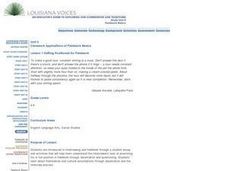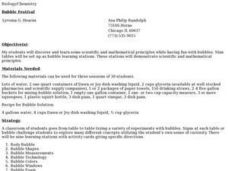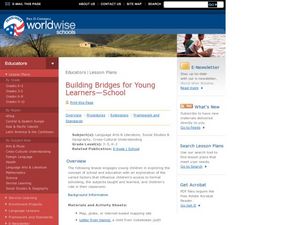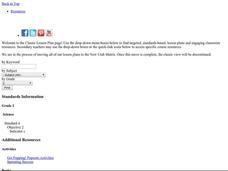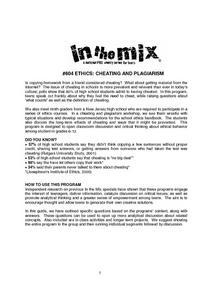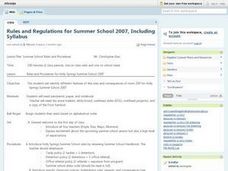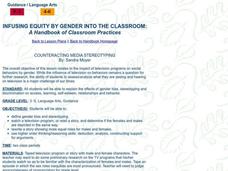Curated OER
How Does Evolution Work?
Students investigate how natural selection influences evolution. They complete a hands-on lab simulation of natural selection, and replicate a real experiment and examine the interplay between selection factors in a population of guppies.
Curated OER
Teddy Bear Project
Students take home an Australian Teddy Bear home and draw pictures, photograph, write or verbalize stories of what the bear did at their home. They make a book that is sent to their partner class.
Curated OER
ADULT ESOL LESSON PLANS--Obtaining Employment
Students examine all the techniques required to look good for an interview in order to make a good impression and build up of your confidence level to do well on the job. They soon realize that dressing the part is vital to landing a job...
Curated OER
Exercise in creating drawings for field notebooks
Learners (with a partner) draw and describe a leaf in its natural setting, and then re-find leaves drawn and described by classmates. The point is to have them start to think about observations in science, what to put in a field...
Curated OER
World Population Activity II: Excel
Students import UNEP World population data/projections from either the World Population Prospects: The 2002 Revision Population Database - UN Population Division or a text file. They graph this data by itself, and then along with...
Curated OER
Getting Positioned for Fieldwork
Students examine interviewing and fieldwork through a student essay and activities that help them understand the interviewer's task of examining his or her position in fieldwork through observation and questioning. They explore cultural...
Curated OER
Bubble Festival
Young scholars practice scientific inquiry while learning about bubbles. In this lesson about bubbles, students explore characteristics of bubbles. Young scholars move through nine different "bubble" stations following directions and...
Alabama Learning Exchange
Systems of the Human Body
Students research systems of the human body. In this biology lesson, students read the book Yucky Story and identify the systems of the human body. Students create a Powerpoint presentation to demonstrate their knowledge of the content.
Curated OER
Bats and Boas Abound
Students investigate Puerto Rican boa constrictors and bats. For this animal science lesson, students read an article about the bats and snakes found in Puerto Rico. Students use various art supplies to create a diorama of the habitat of...
Curated OER
Building Bridges for Young Learners- School
Young scholars examine the purpose of education. In this schooling lesson, students read a letter from a child in Uzbekistan. Young scholars compare and contrast their schooling to children around the world.
Curated OER
Breaking News English: Iran's Ambassador Change
For this Iran's Ambassador change worksheet, students read the article, answer true and false questions, complete synonym matching, complete phrase matching, complete a gap fill, answer short answer questions, answer discussion...
Curated OER
Hidden Animals
Students predict the safest seashore substrate for animals. For this animal habitat experiment, students predict, test their hypothesis, and record data about how wave shocks affect animals living on either sand, gravel or rock.
Curated OER
Fable of the Fainting Goat
Second graders explore animal life by reading children stories in class. In this goat fable lesson, 2nd graders read several books which describe the different myths and folklore about goats. Students identify the needs of living animals...
Curated OER
My Little Seed House
Second graders explore plant life by participating in a germination activity. In this botany lesson, 2nd graders read several books about seed germination including Sunflower House and Tiny Seed. Students identify the necessary elements...
Curated OER
Ethics: Cheating and Plagiarism
Pupils examine the reasons why students cheat and plagiarize material. They discuss what could have been done to avoid cheating and copying material. They answer questions to end the instructional activity.
Curated OER
Looking At the World Through Different Eyes
Students are introduced to the concept of reframing as a problem-solving alternative. They present the value of incorporating adults into their suport system. Students draw what they think Creep Face and Maggie saw when they looked...
Curated OER
Ready to Remain Safe
Eighth graders discuss making the wrong decisions because of peer pressure and the consequences of those actions. As a class, they identify the positive and negative consequences based on a variety of scenerios. To end the lesson, they...
Curated OER
Multiplying Decimal Numbers: Using Zeros as Placeholders
Explore decimals with upper graders. They solve problems from their textbook involving decimal multiplication. Afterward, as a class, they check their answers by comparing them to those projected with an overhead projector.
Curated OER
Big Dogs, Little Dogs
Students explore how dogs are industrious workers and beloved pets, helpful companions and highly paid entertainers.
Curated OER
The New Explorers: Miracle Dolphin
Students view "Miracle Dolphin" which tells the fascinating story of a fable that came true and explores both the story and the science of Holly's life among the Bedouins of Nuweiba El Muzena.
Curated OER
LESSON PLANS
Second graders encounter how the native and Spanish cultures influenced art on Colonial New Mexico. They experience some of the games, art and tools of colonial New Mexico. Students strive to increase new vocabulary. They also access how...
Curated OER
Summer School Rules and Procedures
Students examine the rules and procedures involved for taking summer school. They determine the consequences and rewards surrounding the compliance or non compliance with school expectations. The features of rules and expectations are...
Curated OER
COUNTERACTING MEDIA STEREOTYPING
Learners explore the effects of gender bias, stereotyping, and discrimination.
Curated OER
I Am More Than You See
Students examine their personal interests in culture/ethnicity and what they value in terms of physical vs. Personal characteristics. They discuss the forces in society that cause gender discrimination.







